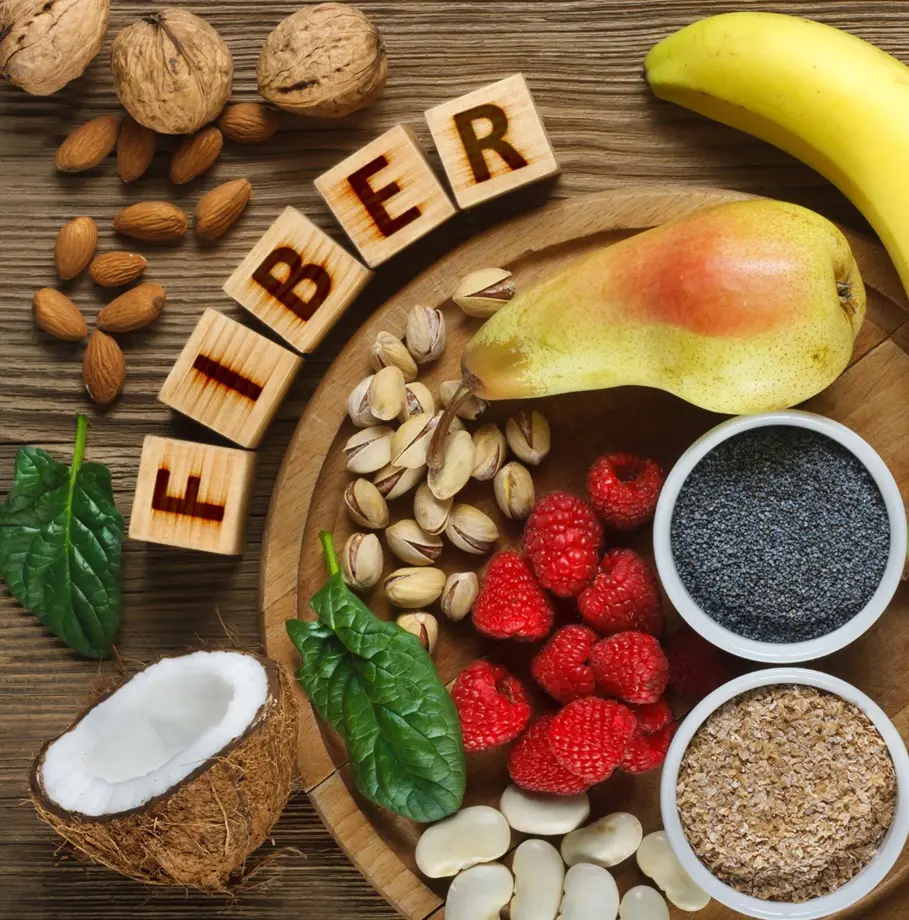How To Make Sauerkraut At Home?

This post may contain affiliate links. If you make a purchase through links on our site, we may earn a commission.
Let's go back to the hearts of traditional fermentation with many people's favorite sauerkraut recipe. While making this dish, you will see the magic of how a simple cabbage transforms into tangy, probiotic-rich sauerkraut. As a fan of ancient preservation techniques, I'm so excited to share my comprehensive guide to making authentic sauerkraut.
This traditional method keeps all the flavor and goodness unharmed, which gives you the perfect mix of tanginess and crispiness. If you've always wanted to try making sauerkraut but stopped after reading the recipes, it's time to shake off all that laziness and give it a go. Trust me, you will love it.
Essential Ingredients And Tools
A traditional fermented food, sauerkraut is mainly made from finely chopped cabbage and salt. The fermentation process uses helpful bacteria that turn the sugars in the cabbage into lactic acid. This acid acts as a natural preservative and gives sauerkraut its sour taste. It is an old way of preserving cabbage that makes lasting your cabbage for years and makes it very rich in probiotics, vitamins, and minerals.
Ingredients
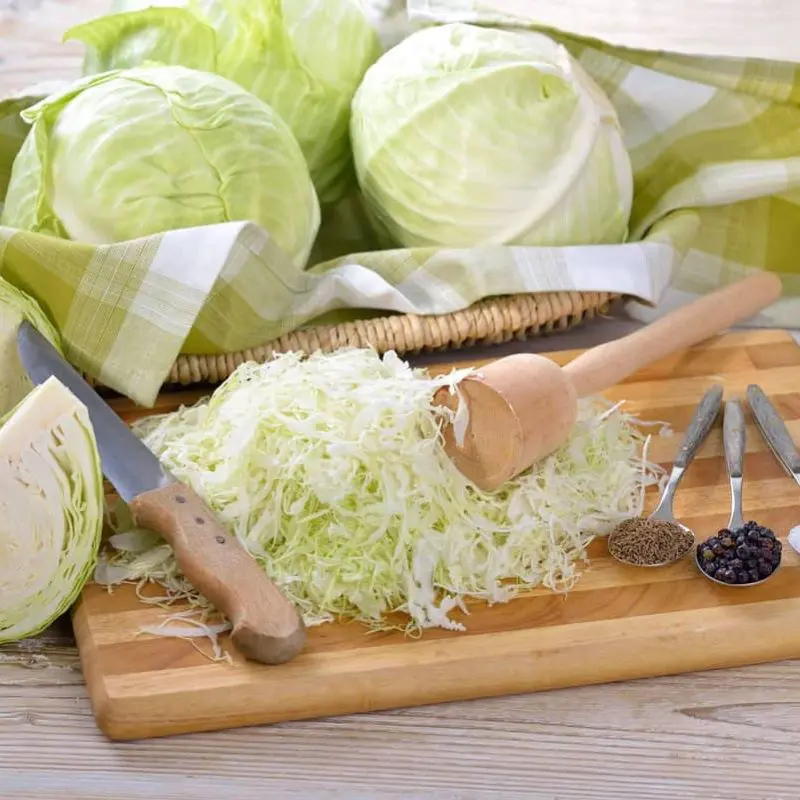
Fortunately, very few things are required to prepare this wonderful and prebiotic-rich dish. The ingredients are:
- Cabbage: One obvious ingredient, you need about 2 pounds of fresh cabbage (green or red).
- Salt: Non-iodized salt such as sea salt or kosher salt.
- Optional Flavorings: If you love some flavor and spiciness then you can add ingredients like caraway seeds, garlic, or spices.
- Veggies: For a more flavorful taste, you can add other veggies like carrots, radishes, and cucumbers as you wish.
Equipment
The best and easy part is while making sauerkraut you don't need any special equipment or a large amount of money to be spent. Here's what you'll need:
- A large mixing bowl
- A sharp knife or mandolin for shredding
- Clean glass jars or fermentation crock
- A weight to keep the cabbage submerged (this could be a smaller jar filled with water or a fermentation weight)
- A clean cloth or lid to cover the jars
Selecting the Perfect Cabbage
The basis of great sauerkraut lies in choosing the right cabbage. So, we suggest you look for:
- Fresh, dense heads that feel heavy for their size
- Crisp, bright leaves without blemishes
- Organic cabbage when possible (fewer pesticides)
- Cabbage harvested in season (late fall to winter) for optimal sugar content
How To Make Sauerkraut?
After collecting all the necessary equipment and choosing fresh cabbage let's dive into the process of creating sauerkraut from scratch.
1. Preparation
Start with a clean workspace. Sanitize your equipment and wash your ingredients and hands thoroughly. Remove any damaged outer leaves from your cabbage and cut out the core. Remember to save one or two clean ones for later use (you can use this at the top of the shredded cabbage in the jar).
Tip: When you are finished rinsing the cabbage, turn it upside down and shake off the water in it.
2. Shredding the Cabbage
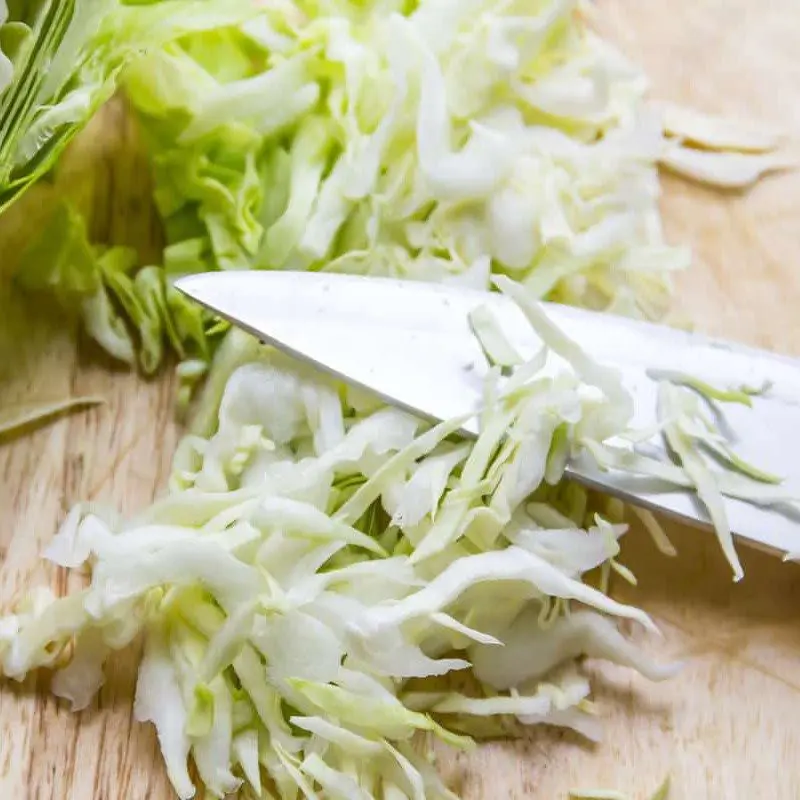
- Quarter the cabbage and remove the core
- Slice into thin strips (about 1/8 inch thick). For this, you can use a knife, mandolin, or any food processor in order to achieve the specific slices you want.
- If you are using mandoline, be extra careful and use the guard
- Place shredded cabbage in your large bowl
Pro tip: The thickness of your cut affects fermentation time and final texture. So, try to make thinner strips because they ferment faster and become softer.
3. Measure Salt
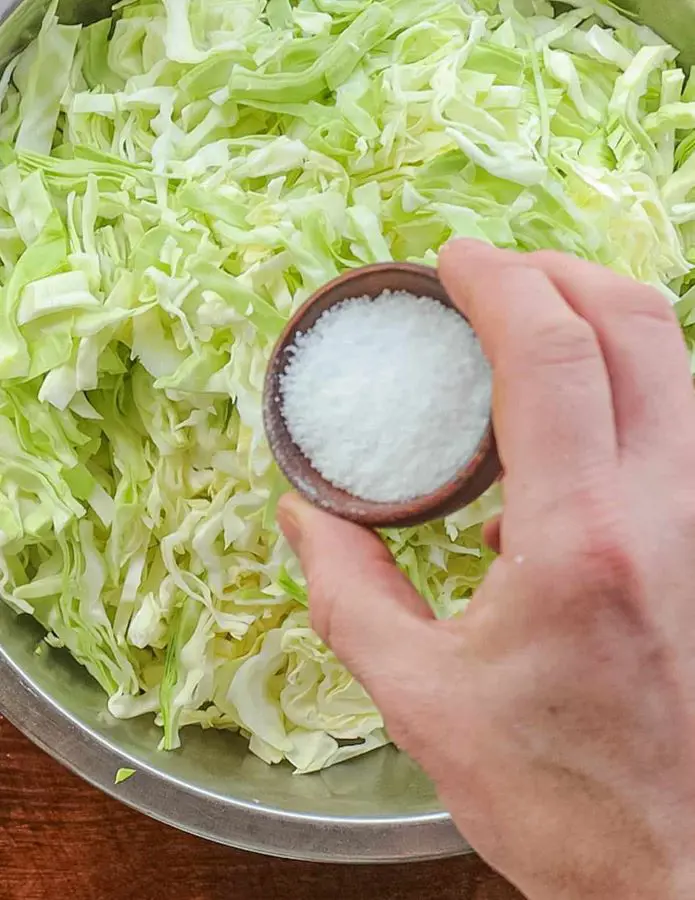
The amount of salt is necessary for fermentation. A general guideline is to use about 2-3% salt based on the weight of the shredded cabbage. For example:
- For 5 pounds of cabbage, use 3 tablespoons of salt
- Sprinkle salt evenly over shredded cabbage
- Toss the cabbage with the salt and let it rest for 10-15 minutes
4. The Crucial Massage
This is where the magic begins:
- After resting, begin kneading and squeezing the salted cabbage with clean hands
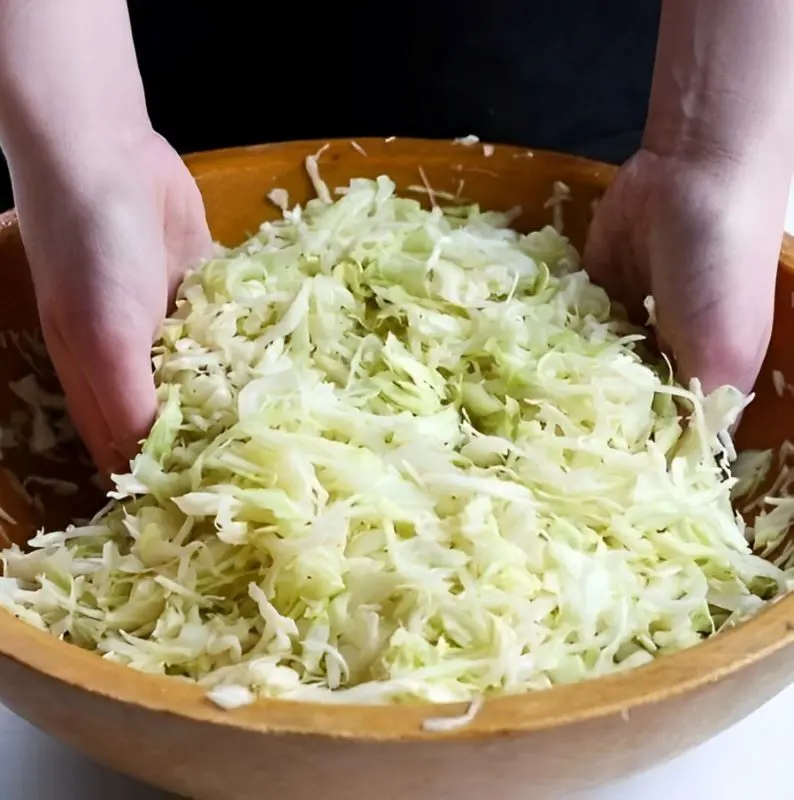
- Continue until cabbage becomes water and reduces in volume by about half
- You will notice the texture change from crisp to softened and wilted
- A good amount of brine should have formed at the bottom of your bowl
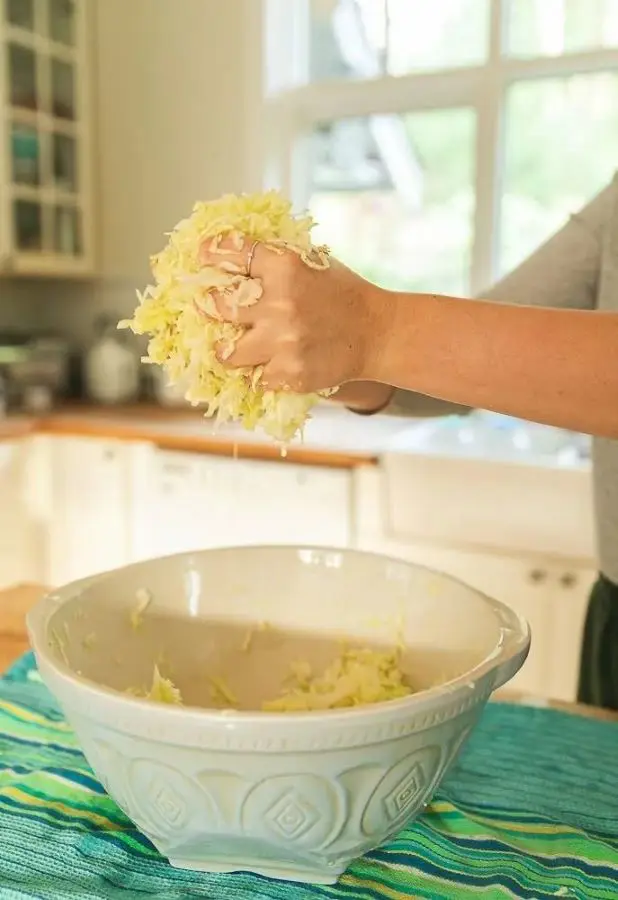
Remember: This step is essential for proper fermentation. Don't rush it.
5. Packing Your Vessel
Proper packing is crucial for successful fermentation:
- Once enough liquid has been released, pack the cabbage tightly into clean jars or your fermentation crock
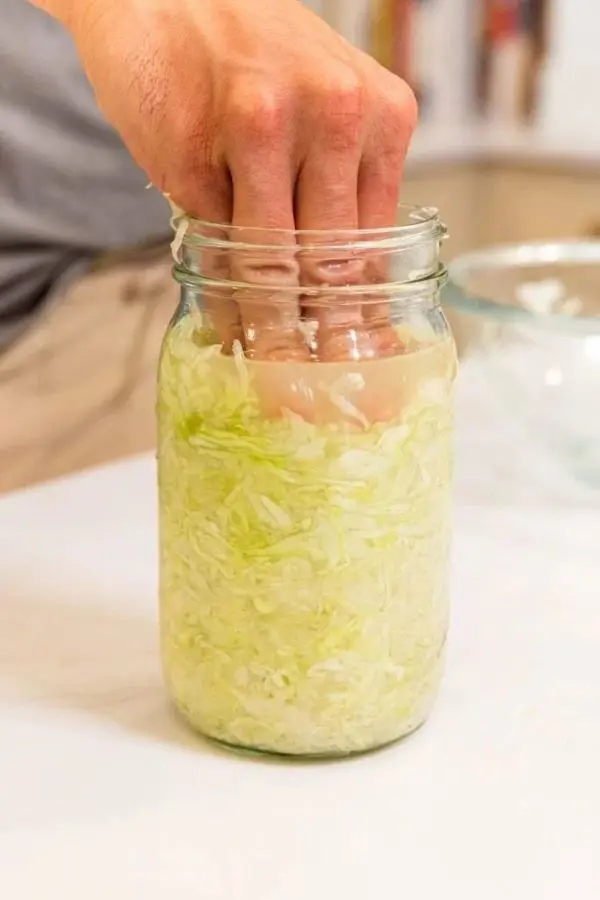
- However, make sure that the cabbage stays under the brine. If the liquid does not cover it, prepare additional brine by mixing 1 tablespoon of salt with 1 cup of water and pouring it into the jar.
- Leave about an inch of space at the top of each jar to allow room for the contents to expand during fermentation.
6. Weigh Down and Cover
- Place a weight on top of the packed cabbage to submerge it below the brine.
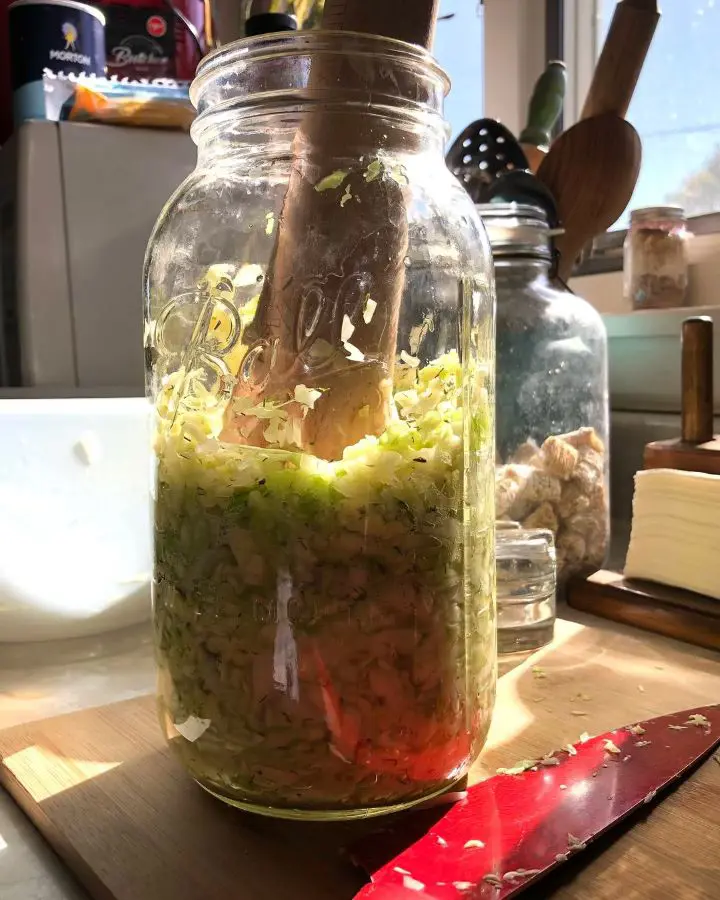
- Cover the jar with a clean cloth or lid to protect it from dust while allowing gases to escape during fermentation.

7. Fermentation Process
- Place your jars in a cool, dark place with a temperature between 65 degrees F and 75 degrees F (18 degrees C- 24 degrees C). You may wonder why this, but keep in mind ideal conditions promote healthy fermentation.
- Over the next few days, check your sauerkraut daily to ensure it remains submerged in brine, and taste it periodically.
- Fermentation can take anywhere from 3 days to several weeks. This all depends on your taste preference and environmental conditions.
- For milder flavor, ferment for about 3-7 days. Likewise, for tangier sauerkraut, allow it to ferment for up to 3 weeks or longer.
How To Store Sauerkraut?
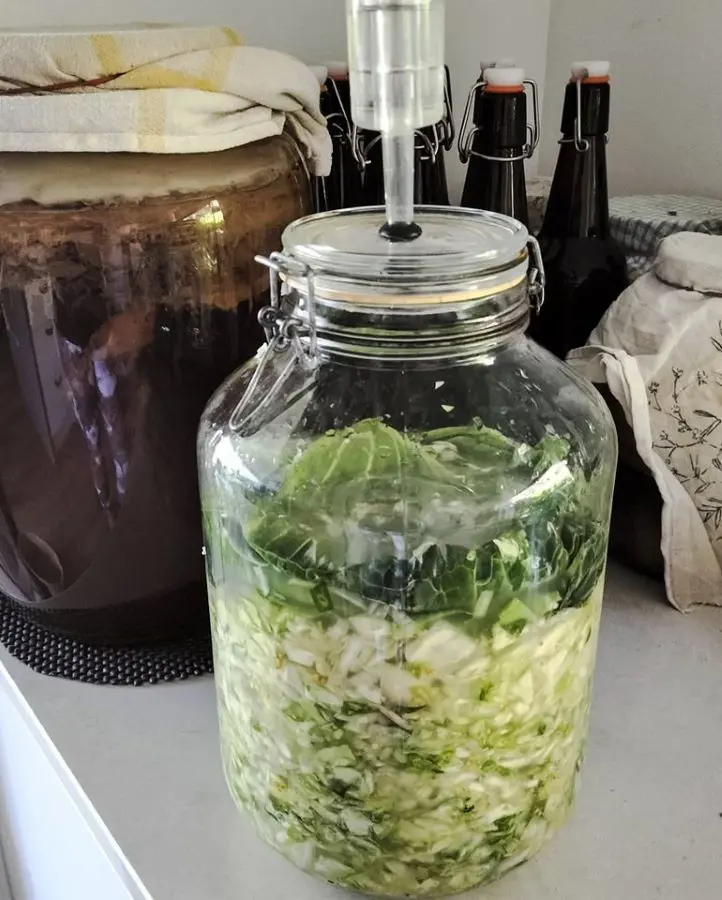
You can taste it after the mentioned days or weeks. Once your sauerkraut has reached your preferred level of sourness, you can store it for long-term use. And no worries about the storing techniques, for ease, we have discussed them below:
- Use mason jars or any other container with perfect sealing that cannot be easily opened. It will help to avoid any access of undesired bacteria into the mix and also helps to extend the fresh shelf life of the sauerkraut.
- As we noted before, after 3-4 weeks your sauerkraut is ready for the next step after which it should be moved to the fridge. This slows down the fermentation process and makes it taste and have a texture that is good for a few months.
- Make sure that the sauerkraut remains submerged in its brine to prevent spoilage. If necessary, you can add extra brine (made from water and salt) to cover the sauerkraut completely.
- If you need to store it in smaller containers, compress the sauerkraut tightly in the new jar and cover it with some of its brine. This minimizes air exposure and helps maintain its quality.
- Regularly check your sauerkraut for any signs of spoilage, like bad smells or changes in color. If you see anything unusual, it's better to throw it away.
Alternative Storage Methods
If you want to store it long-term, consider canning or freezing your sauerkraut:
- Canning: Follow proper canning procedures to ensure safety and longevity.
- Freezing: Put the sauerkraut into the freezer bags, but remember to leave some space for it to expand when it freezes.
Troubleshooting Common Issues
Trying this recipe for the first time or if it is your third time, the process brings a little confusion and in between that confusion, some mistakes can happen. So, for ease, we have discussed some common issues and solutions. Let's have a look:
1. Problem: Mold on Surface
- White film is usually harmless
- Remove any colored mold immediately
- Ensure cabbage stays submerged
- Check salt ration for future batches
2. Problem: Not Enough Brine
- Mix 1 teaspoon salt with 1 cup filtered water
- Add enough to cover the cabbage
- Pack cabbage more tightly next time
3. Problem: Too Salty
- Let it ferment longer
- Rinse before serving if needed
- Reduce salt in future batches
4. Problem: Ignoring Temperature
- Too-cold temperatures slow down fermentations
- Likewise, too warm can lead to off-flavors. So, try to keep it at (65 degrees F-75 degrees F) temperature.
Here are some tips which will make your sauerkraut more delicious and stunning.
- Use quality ingredients: Fresh organic cabbage yields better results than older heads that may lack moisture.
- Experiment with flavors: Feel free to add spices like caraway seeds or garlic for additional flavor profiles.
- Keep everything clean: Ensure all equipment is sanitized to prevent unwanted bacteria from spoiling your batch.
Creative Ways To Enjoys Your Sauerkraut
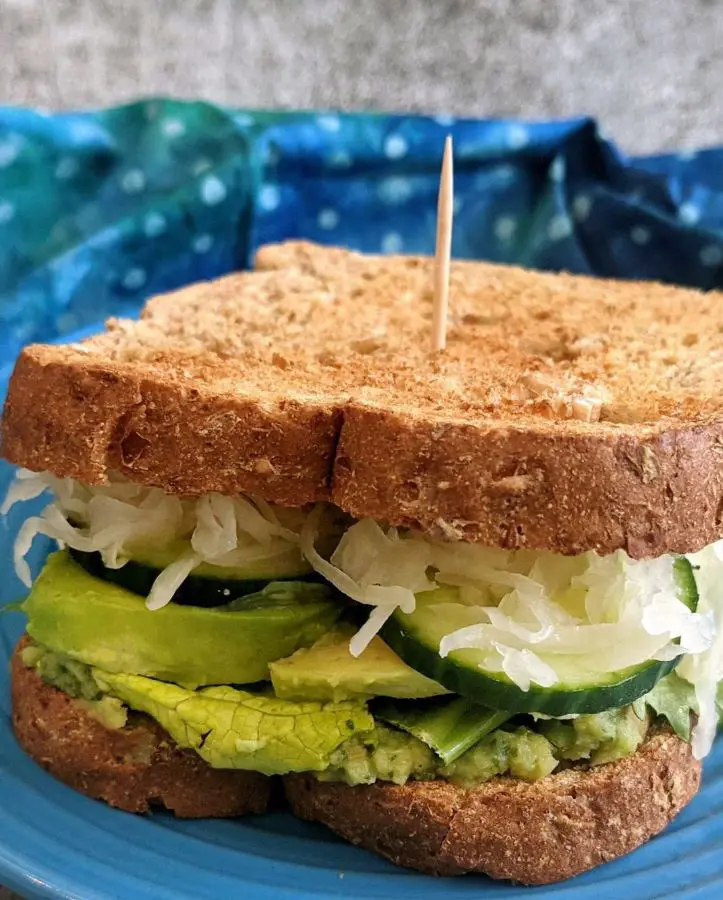
You can enjoy your homemade sauerkraut in different ways that go beyond just eating it straight from the jar. Let me share some creative and tasty ways:
1. In Sandwich: Next time while making the sandwich stop those boring methods of using lettuce or pickles, instead try piling on some tangy sauerkraut. It adds a nice crunch and really livens up the flavors, whether you have it with deli meat, hummus, or anything in between.
2. In Salad: Spread sauerkraut into your salads for a perfect probiotic addition. You can try this dish in coleslaw or mixed greens, as the sourness of sauerkraut complements all other salad ingredients.
3. Burger Toppings: You can decorate your burgers or hot dogs with tangy sauerkraut, as the acidity inside this dish balances out rich, savory flavors beautifully.
4. Soup or Stew Addition: Stir some sauerkraut into potato soup, beef stew, or any other hearty, zesty dish. It adds a delectable tanginess that takes the whole meal to the next level.
5. Breakfast Mix-In: Don't forget to get innovative with sauerkraut at breakfast. Fold it into scrambled eggs or omelets for a unique twist. The tastes might surprise you, but they work!
6. Grain Bowl Topping: For instance, why not include your homemade sauerkraut in a grain bowl that you prefer, whether quinoa or brown rice, or other grains of choice. It furnishes a nice crunch and brightness to balance all the other ingredients.
7. Taco Filling: Instead of the usual taco toppings, use sauerkraut as the star. Its tang pairs perfectly with spicy taco seasonings.
8. Party Dip: Combine sauerkraut with cream cheese or Greek yogurt to make a tangy, probiotic-packed dip. You can serve it with crackers, veggies, or pita for a unique appetizer.
Health Benefits Of Homemade Sauerkraut
Apart from being a delicious addition to food, sauerkraut has a lot of health benefits related to different health issues. To make it easier, here is a simple rundown of its health benefits that show how worthable adding this fermented food to your diet.
1. Improves Digestion
So far, you are aware of its probiotic richness but what do probiotics actually do? These bacteria are healthy and good for your gut. Similarly, it balances the gut microbiome, hence it becomes easier for your body to digest food. These probiotics can minimize constipation and looseness of the bowels by supplying the mass of stool, as it soaks up excessive moisture. What also helps, is the fiber in sauerkraut promotes digestion by helping it to go through regular bowel movements.
2. Boosts Immune Function
Consuming sauerkraut can boost your immunity because they are a source of probiotics that assist to regulate the growth of bad bacteria hence preventing infections. Further, vitamin C and iron in sauerkraut also strengthens the immunity of the human body.
3. Aids Weight Management

Maintaining weight or reducing it is many people's concern. Luckily, sauerkraut stands well for this. Because it has few calories and lots of fiber, which can keep you feeling full for a prolonged time. Plus, some research and studies suggest that the probiotics in sauerkraut could help reduce the amount of fat your body absorbs.
4. Reduces Inflammation
The probiotics in sauerkraut encourage a healthy gut environment, which can potentially lower the risk of conditions related to inflammation such as heart disease and autoimmune disorders.
5. Supports Heart Health

Sauerkraut contains potassium, which helps regulate blood pressure, and its fiber content can assist in managing cholesterol levels. Moreover, vitamin K2 found in sauerkraut may prevent calcium buildup in arteries, reducing the risk of heart disease.
6. Enhances Mental Health
Some studies suggest that the presence of probiotics in the sauerkraut also helps to regulate gut health and can hence help people suffering from anxiety and depression.
7. Provides Essential Nutrients
Notably, sauerkraut too contains many vitamins and nutrients including vitamins C, K, potassium, vitamin B6, as well as iron. Most of these nutrients benefit the general body's health and aid several bodily functions. Besides, in the process of fermentation, these nutrients become bioavailable, meaning your body can absorb them more easily.
Recent posts
Lifestyle
Lifestyle
How Much Omega-3 Per Day Is The Right Amount?
Omega-3 fatty acids are advantageous for so many aspects of health-from heart, brain to joints. So, "How much to add" can be a general query of many. To help you get through this, and to let you know the appropriate amounts needed depending on the ag...
Lifestyle
How Much Protein Should You Consume In a Day?
Protein is one of the macronutrients that are essential in the human body for tissue building, repair, immunity and hormonal balance. The Recommended Daily Allowance or RDA covers a daily protein allowance of 0.8 grams per kilogram of body weight wh...
Lifestyle
How To Fillet A Fish?
Nothing beats the deep happiness of filleting your own fish, but only if you have done it before. While beginners might find it challenging at first, the process becomes easier with the right guidance. Whether you are filleting with a fresh catch or ...
Lifestyle
How Much Fiber Do You Need On Your Diet?
Fibers are what keep our digestive system healthy. Many of us have heard the buzz about how fibers are important and how they keep "things moving", making these nutrients our gut friends. If after knowing all the basics, the amount of fiber to be add...
Lifestyle
Is Apple Cider Vinegar Good For Weight Loss? How To Use
Shedding those extra pounds is a tough task for all. And for individuals in this journey, looking for trends that have gained significant traction is not a new thing. One such trend that has caught the attention of many is the use of apple cider vine...
Lifestyle
How to Digest Food Faster? 11 Natural Ways To Improve
As we have stepped into the world of a more sedentary lifestyle, all of us are more prone to physiological disorders. One of the consequences of not getting exposed to proper exercise is a delay in the digestion rate. For people who are on desk jobs,...



